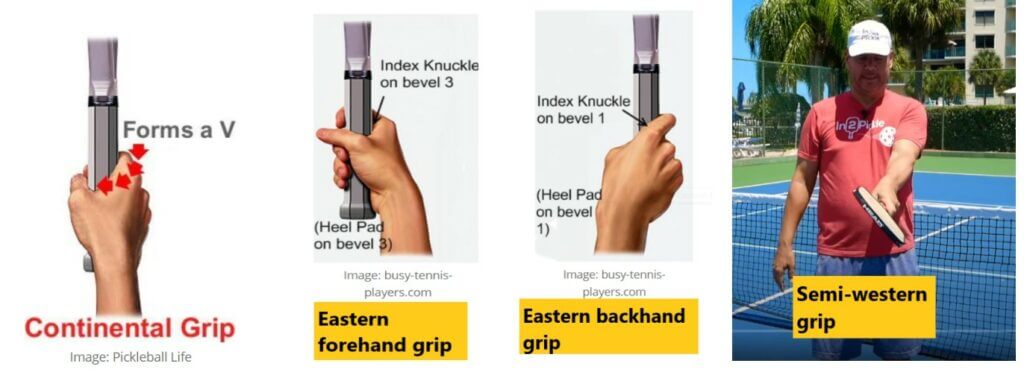by Jenny Foster
Grips are one of the important skills that every pickleball player must develop and excel in. With regard to this topic, pickleball players must be able to recognize the different types of grips and how each one would benefit them in a pickleball match. Now, let’s start and dig into the various types of pickleball grips.
- Continental grip
In the continental grip, the v-shaped part of the hand, which is formed by the thumb and forefinger, should be placed above the top bevel, which is a flat spot on the paddle handle, in alignment with the grid paddle. To further illustrate, the hand holds the paddle like a hammer.
Others call the continental grip the V grip, understandably because the grip should be held with the V-part of the hand.
The continental grip offers several benefits. First, this grip may be the most used grip when hitting the different types of pickleball shots. Basically, this grip can be used in various forehand and backhand pickleball shots, like an arched serve, returns, dinks, and volleys. With the continental grip, the paddle can also be held at a neutral position, which gives a pickleball player the advantage of hitting the ball low.
- Eastern forehand grip
In eastern forehand grip, the hand is slightly behind the handle, with the knuckle of the forefinger placed along the direction of the flat side of the paddle. Meanwhile, the v-part of the hand is positioned at the corner of the bevel. Basically, the eastern forehand grip is preferred by those who always want their paddle in neutral position.
The easter forehand grip can be used to drive the ball with the right stability or shots with added topspin, shots that require a neutral paddle face. For the topspin, the eastern forehand grip works effectively in brushing up the ball, thus adding the topspin smoothly. Some players also opt to use the eastern forehand grip in hitting volleys and in certain cases, when smashing the ball.
Meanwhile, the eastern forehand grip is not recommended for backhand shots because it will force the hand to be at the front of the handle, which is basically a weak position. To successfully use the eastern forehand grip to do a backhand shot, a pickleball player must also use their other hand to add support to the paddle.

- Eastern backhand grip
To use the eastern backhand grip, starting from the continental grip, one must turn or rotate their hand inward until the knuckle of the index finger is on the top of the handle, in alignment with the paddle grid. This grip gives a player the advantage of a strong hitting position that uses the backhand. In addition, the paddle face is consistently neutral when using the eastern backhand grip.
The eastern backhand grip is preferred by those who drive the ball with their backhand. This grip can also be used to create a backhand topspin.
- Semi-western grip
The semi-western grip is possibly the most rarely used grip, but it can be mostly observed in pickleball players who have previously played tennis. In the semi-western grip, the knuckle forefinger, starting from the continental grip, is almost at the other side of the handle, which places the paddle in a downward-angle position.
Given the tilted paddle position, this grip forces the player to swing up when hitting the ball. In this case, the player can generate a topspin.
Semi-western grip is not something that is recommended for every player. In addition, it is not a viable option for making backhand shots, because it would require the support of the other hand.
